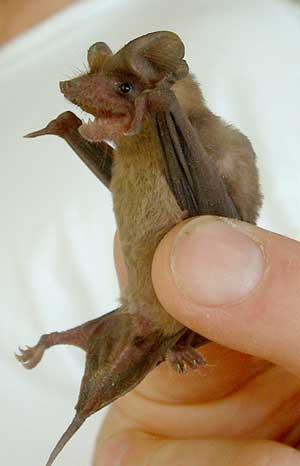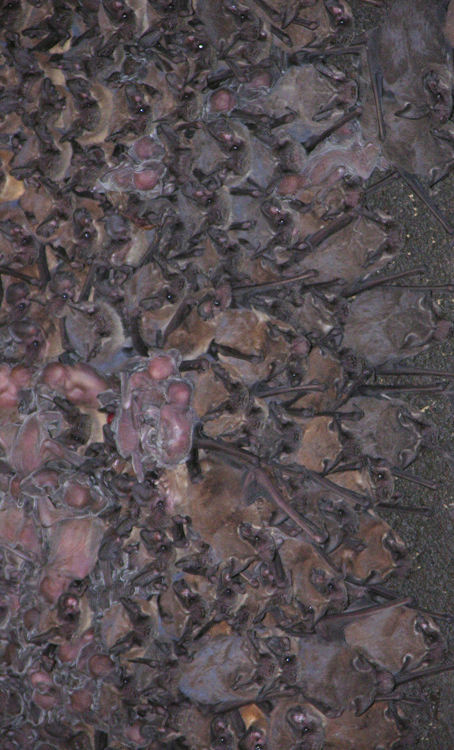Guide to the bats of Montserrat
Artibeus jamaicensis Chiroderma improvisum Brachyphylla cavernarum Noctilio leporinus Ardops nichollsi Sturnira thomasi Monophyllus plethodon Molossus molossus Tadarida brasiliensis Natalus stramineus Key to Roosts Key to Taxa
Tadarida brasiliensis
(PhotoA. Hartpence)
(Photo S. Pedersen)
Brazilian Free-tailed Bat - Tadarida brasiliensis
STATUS: This species is widespread throughout South, Central, and North America, though they are typically found only in moderate numbers in the northern Lesser Antilles.IDENTIFICATION: These are small bats with a wingspan of just under 30cm. The wings are long and tapered at the tips. The mouse-like tail projects beyond the tail membrane hence the name "free-tailed bat". The back legs are short and powerful making these animals good climbers. Their toes have characteristic long hairs that provide feed-back to the bat about flight speed and turbulence. The ears are large and "square" looking, meeting above the eyes giving the impression that these bats are wearing a small hat. The upper lips have deep wrinkles, unlike the lips of the related velvety house bats (Molossus).
ROOSTS: Throughout the region, these bats have been found in a wide variety of roosts, including caves, buildings, bridges, culverts and hollow trees. But in general, they are a crevice-dwelling bats and can squeeze into tiny cracks, thereby making them difficult to find. They tend to remain silent during the day, but make very high-pitched "twittering" sounds before emerging from the roost at dusk.DIET: Brazilian free-tailed bats eat only flying insects, preferring moths and beetles. They feed in open spaces (not in vegetation or forests), often 20-50ft above the ground. The amount of fat stored in the body seems to vary seasonally, decreasing in the dry season and increasing in the wet. Their droppings are very small (5mm x 2mm), and crumble to reveal a fine powder made up by silvery insect exoskeletons.
REPRODUCTION: Mating occurs around March, with a single young (occasionally twins) isborn about three months later. Pregnant females form nursery colonies (no adult males) where they raise their young. In North America, nursery roosts containing millions of individuals are common; but in the Lesser Antilles smaller roosts are common (100-1000 bats). Young bats are capable of flying at 5-6 weeks of age.
SIZE: Forearm length – 38mm [range 35-46mm]; Mass– 8.6g [range 9-14g]; Wingspan - approx. 280mm; Head+body length - approx. 50mm.
COMMENT: These bats eat huge numbers (200-600 mosquito-sized) insects each night. Though they are known to occasionally inhabit abandoned buildings, they prefer to retreat into natural roosts.
REFERENCES: Mammalian Species No. 331: Tadarida brasiliensis by Kenneth T. Wilkins 10pp (American Society of Mammalogists, 1989)
See Entry: Walker's Mammals of the World Online version 5.1, by Ronald Nowak, 1997


